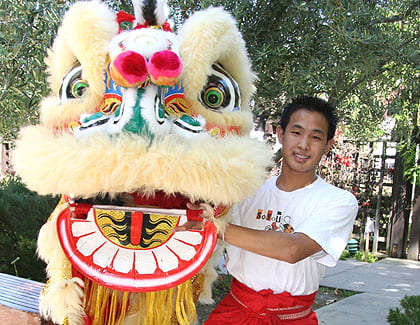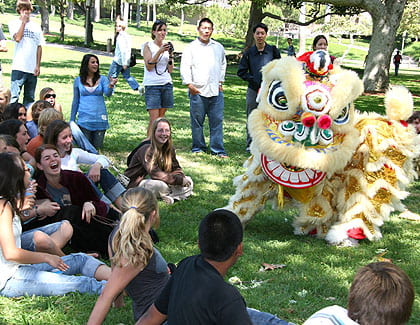Lion king
Jeffrey Chin and other UCI students find new audiences for ancient Chinese dance
As drums sound in Aldrich Park, a golden Chinese lion leaps and prances before a group of high school students. UCI undergraduate Alison Wu sports the lion’s head, while Thu Ha works the tail – playfully wagging her backside to the crowd.
“It’s a piñata!” a student jokes.
Jeffrey Chin, a junior film studies major, explains how the lion’s movements are rich in symbolism, a dance designed to bring good fortune and scare away evil spirits. A third-generation Chinese American, Chin is helping bridge the gap between cultures while preserving a “2,000-year-old living art form.”
“Compared to a person running around in a mask on Halloween, this is a ballet,” he says. “Sometimes the lion dance is not appreciated the way it should be as a cultural experience.”
Chin, Wu and Ha belong to the Dragon Horse’s Southern Young Tigers Lion Dance Team, a group Chin co-founded at UCI in January 2005 to preserve and promote Chinese lion dance. The 12-15 members come from varied ethnic backgrounds.
“We’re a diverse team. We’ve had Filipino, Korean, Taiwanese, Vietnamese and Latino members,” Chin says. “I didn’t want to limit the group.”
Southern Young Tigers perform the lion dance one or two times a month at schools, restaurants, hospitals and cultural events; recently they performed for students in the Newport-Mesa Unified School District at the “Experience China” symposium sponsored by the School of Social Sciences Global Connect @ UCI program. They’ve also performed with the other lion dance team at UCI, the Vietnamese Student Association’s Southern Wind, as well as UCLA’s Association of Chinese Americans lion dance team, co-founded by Chin’s brother. (All three teams have roots in the Dragon Horse Lion Dance Troupe of San Francisco.)
Mastering the dance requires months, even years, of practice. Chin began training when he was still in preschool.
“I started late,” he says. “I didn’t get to perform in the lion head until I was in middle school.”
It’s a balancing act. Dancers must maintain martial arts stances while holding up the costume; the head alone weighs about 5 pounds (bamboo and papier-mâché heads on older models are three times heavier). The person handling the head has to correctly evoke emotions and coordinate with the dancer working the tail.
“It takes a lot of skill and training to make the lion come alive,” Chin says.



